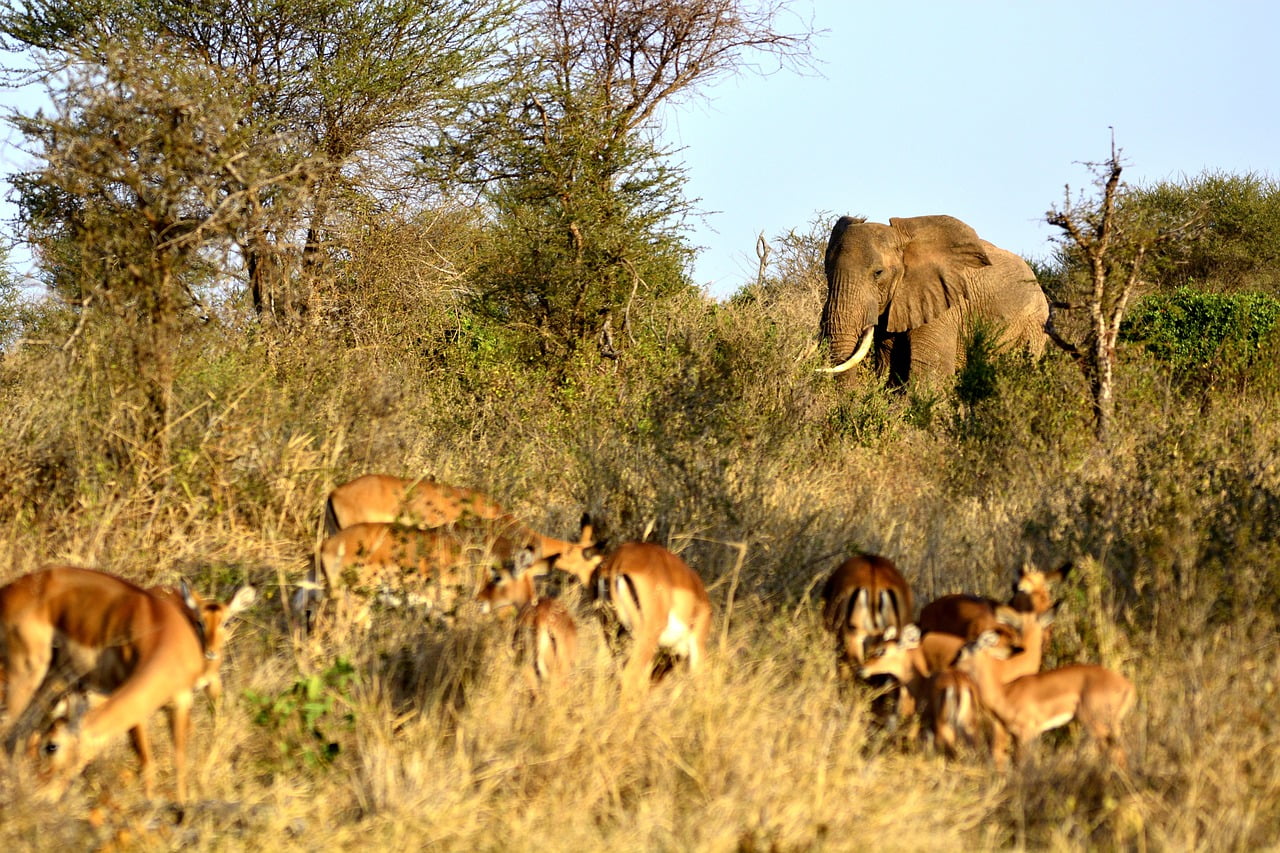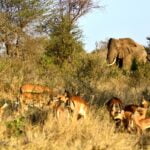What are five attractions in Tanzania?, Tanzania is a land of astonishing natural beauty and diverse cultures, is a true gem in East Africa. From its pristine national parks teeming with wildlife to its idyllic beaches along the Indian Ocean, Tanzania offers a myriad of attractions that will leave travelers in awe.
What are five attractions in Tanzania?
In this article, we’ll embark on a journey through this enchanting country, discovering five must visit attractions that will captivate your heart and soul.
1. Serengeti National Park: The Great Migration Spectacle

No discussion about Tanzania’s attractions can begin without mentioning the iconic Serengeti National Park. This vast wilderness spans approximately 14,750 square kilometers and is renowned worldwide for its breathtaking landscapes and incredible wildlife sightings. One of the park’s most remarkable events is the annual Great Migration, a natural phenomenon that sees millions of wildebeests, zebras, and other herbivores embark on a treacherous journey in search of greener pastures.
The Great Migration
The Great Migration typically begins in the southern Serengeti around December, as the wildebeest and zebras give birth to their young. It is a time of abundance and new life, and predators such as lions, leopards, and cheetahs are in abundance to capitalize on the vulnerable prey.
As the dry season progresses, water and food sources become scarce in the southern Serengeti, forcing the herds to start their journey northward. This migration is fraught with peril, as they must cross the Grumeti River and the Mara River, where lurking crocodiles lie in wait. Witnessing the heart-stopping river crossings is one of the most sought-after experiences for wildlife enthusiasts.
When to Visit the Serengeti
To witness the Great Migration in all its glory, plan your visit between June and July when the herds are usually crossing the Mara River. However, if you prefer a quieter and more intimate safari experience, visiting during the shoulder seasons, like March to May or November, can offer you solitude amidst the stunning landscapes and abundant wildlife.
2. Mount Kilimanjaro

Mount Kilimanjaro, the highest peak in Africa, looms majestically over Tanzania’s landscape, beckoning adventurers and trekkers from around the world. This dormant stratovolcano stands at an impressive 5,895 meters (19,341 feet) above sea level, offering an exhilarating challenge for those seeking to conquer its lofty summit.
The Kilimanjaro Experience
Climbing Kilimanjaro is an unforgettable adventure, providing climbers with a range of ecosystems to explore. The journey to the summit takes trekkers through lush rainforests, alpine meadows, and a barren lunar-like landscape near the peak. The ascent is not technical, making it accessible to a wide range of hikers, although it is physically demanding.
There are several routes to choose from, each with its own unique character and level of difficulty. The Marangu Route, often called the “Coca-Cola Route,” is the most popular due to its relative ease and comfortable hut accommodations along the way. Other routes, like the Machame Route or the Lemosho Route, offer a more challenging and remote experience.
Climbing Tips
Climbing Kilimanjaro requires careful planning and preparation. Here are some essential tips for a successful ascent:
- Acclimatization: Take your time to acclimatize to the altitude to prevent altitude sickness.
- Proper Gear: Invest in high-quality gear, especially cold-weather clothing and a sturdy pair of boots.
- Professional Guides: It’s mandatory to have a local guide and a support team when climbing Kilimanjaro.
- Fitness: Be physically prepared for the hike, including cardiovascular endurance and strength training.
Climbing Kilimanjaro is not just about reaching the summit; it’s about the journey, the breathtaking vistas, and the sense of accomplishment as you stand atop Africa’s highest point.
3. Zanzibar

Just off the Tanzanian coast lies Zanzibar, an archipelago consisting of two main islands, Unguja (often referred to as Zanzibar) and Pemba, as well as several smaller islets. Zanzibar is often associated with pristine beaches, aromatic spices, and a rich cultural heritage.
White Sands and Crystal Waters
Zanzibar’s beaches are the stuff of dreams. With powdery white sands that seem to stretch forever and turquoise waters that invite you to take a dip, it’s no wonder that Zanzibar is a paradise for sun-seekers. Whether you’re looking for a lively atmosphere with water sports and beach bars or a secluded spot to unwind in solitude, Zanzibar has it all.
Some of the most popular beaches on the island include Nungwi, Kendwa, and Jambiani, each offering its own unique charm and activities. Nungwi is known for its vibrant nightlife, Kendwa for its tranquil shores, and Jambiani for its kiteboarding opportunities.
Spice Tours
Zanzibar is often referred to as the “Spice Island” due to its history of spice cultivation. Taking a spice tour is a must-do activity on the island. Wander through lush plantations where cloves, cinnamon, nutmeg, and other spices flourish, and learn about their cultivation and culinary uses. The intoxicating scents and flavors of Zanzibar will leave you with a newfound appreciation for these aromatic treasures.
Historic Stone Town
Stone Town, the historic heart of Zanzibar City, is a UNESCO World Heritage site and a testament to the island’s rich history. This labyrinthine town is a blend of Swahili, Arab, Indian, and European influences, reflected in its architecture, culture, and cuisine.
Wander through narrow alleyways, visit the Sultan’s Palace Museum, explore the Old Fort, and browse the bustling markets. Don’t forget to sample the local street food, which includes mouthwatering dishes like Zanzibari pizza and seafood curry.
4. Ngorongoro Conservation Area: A Natural Wonder

The Ngorongoro Conservation Area, often referred to as the “African Eden,” is a testament to the incredible biodiversity of Tanzania. This unique conservation area encompasses a variety of ecosystems, from grasslands and savannahs to forests and wetlands. At its heart lies the Ngorongoro Crater, a massive volcanic caldera that is home to an astonishing array of wildlife.
The Ngorongoro Crater
The Ngorongoro Crater, with its steep crater walls and lush floor, is often likened to a natural Noah’s Ark. It’s home to approximately 30,000 animals, including the Big Five (lion, elephant, buffalo, leopard, and rhinoceros), as well as countless other species of mammals, birds, and reptiles.
Safari enthusiasts and photographers flock to the Ngorongoro Crater for its unparalleled wildlife viewing opportunities. The chance to witness predators in action, such as lions hunting their prey, is a highlight of any visit.
Conservation and Cultural Heritage
The Ngorongoro Conservation Area is not only a sanctuary for wildlife but also a place where the Maasai people have coexisted with nature for centuries. The Maasai still inhabit the region, practicing their traditional way of life alongside modern conservation efforts.
Visitors can engage in cultural tours and visit Maasai villages to learn about their customs, traditions, and the challenges they face in balancing their way of life with conservation goals.
5. Tarangire National Park: A Hidden Gem
While the Serengeti and Ngorongoro Crater steal the spotlight, Tarangire National Park quietly charms those who seek a more secluded safari experience. This park, located in northern Tanzania, is known for its stunning landscapes, abundant wildlife, and the iconic baobab trees that dot the terrain.
Wildlife Abundance
Tarangire National Park is particularly famous for its large elephant herds. During the dry season (June to October), thousands of elephants gather near the Tarangire River, making it one of the best places to see these majestic creatures up close. In addition to elephants, the park is home to a variety of wildlife, including lions, leopards, cheetahs, giraffes, zebras, and numerous bird species.
Scenic Beauty and Baobab Trees
The park’s landscape is a blend of open grasslands, swamps, and acacia woodlands, making it a diverse habitat for wildlife. What truly sets Tarangire apart, though, are the massive baobab trees that stand like ancient sentinels across the park. These iconic “upside-down trees” are not only a photographer’s dream but also provide much-needed shade and sustenance for the park’s inhabitants.
Safari Adventures and Photographic Safaris
Tarangire offers excellent game drives, walking safaris, and even night safaris for those looking to experience the park’s wonders in different ways. Photographers, in particular, will find Tarangire to be a treasure trove of stunning landscapes and captivating wildlife.
Conclusion
Tanzania, with its mesmerizing landscapes, rich wildlife, and vibrant cultures, is a destination that captures the hearts of travelers from all corners of the globe. From the awe-inspiring Great Migration in the Serengeti to the pristine beaches of Zanzibar, and the dramatic beauty of Mount Kilimanjaro to the wildlife spectacle of Ngorongoro Crater and Tarangire National Park, Tanzania has it all.
Whether you’re a seasoned safari enthusiast, an intrepid adventurer, or a culture seeker, Tanzania’s attractions will leave you with unforgettable memories and a deep appreciation for the natural wonders and cultural heritage of this remarkable East African nation. So, pack your bags, embark on a journey to Tanzania, and immerse yourself in the magic of this extraordinary land.






